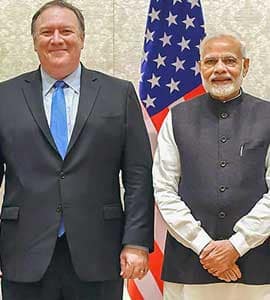US-India Military Cooperation: Pompeo Might Have the “Perfect Carrot” to Dangle in Front of Modi’s Mouth

The US is planning to include India on its International Traffic in Arms Regulations (ITAR) list in order to place it at par with its NATO allies, “Israel”, and a few others for the export of high-level military technologies, which could be the perfect carrot for Pompeo to dangle in front of Modi’s mouth during his visit to the South Asian state next week in order to get him to ditch Russia, and it might actually end up being part of the “surprise” that he recently hinted he has in store for his hosts.
The Indian press is full of reports about the country’s possibly forthcoming inclusion on the US’ International Traffic in Arms Regulations (ITAR) list after two senators inserted the relevant amendments into a draft of the National Defense Authorization Act (NDAA) 2020. Should it pass into law by the end of the year, then India would be legally at par with America’s NATO allies, “Israel“, and a few others for the export of twenty categories of high-level military technologies including ballistic missiles, drones, spacecraft systems, nuclear weapons simulation tools, and directed energy weapons, et al. This could be a real game-changer for its military capabilities and help it to more confidently “contain” China at the US’ behest per their shared “Indo-Pacific” vision, though the Pentagon probably won’t allow India to have this privilege so long as it retains its military partnership with Russia.
Alice Wells, the head of the State Department’s South and Central Asia bureau, implied as much last week in a testimony to lawmakers about the possible consequences of India’s refusal to reconsider its S-400 deal with Russia, which she said could include both CAATSA sanctions and the imposition of severe limits on the country’s military interoperability with the US. If India bends to American pressure and ditches Russia in exchange for THAADs, Patriots, and possibly even F-35s like its Ambassador to the US strongly hinted New Delhi is deliberating doing, then it can avoid this self-inflicted harm to its new military-strategic alliance with Washington though at the expense of its old one with Moscow. The “surprise” that Pompeo suggested that he has in store for his hosts during his upcoming visit to the South Asian state next week might be a formal offer to put India on the ITAR list if it decisively pivots away from Russia.
Truth be told, that would be a pretty attractive carrot for Pompeo to dangle in front of Modi’s mouth and might even get the re-elected leader to finally bite the bait. India is obsessed with China and the global pivot state of Pakistan, and it’s the excessive fearmongering about the latter in response to the suspicious Pulwama incident and subsequent Bollywood-like “surgical strike” that’s largely believed to have been responsible for Modi receiving such a huge mandate at the polls last month, so it can’t be underestimated just how important New Delhi would regard this unprecedented expansion of its military-strategic alliance with Washington. Russia can’t provide India with the game-changing capabilities that it’s seeking in its quest to “contain” China and “punish” Pakistan, ergo why it began its pro-American pivot in the first place because the US is more than eager to meet New Delhi’s needs in order to advance their shared strategic objectives.
Even though the two allied Great Powers are presently in the midst of what the Mainstream and Alternative Medias are misinterpreting (and in some cases, deliberately misreporting) to be a so-called “trade war”, their economic disagreements with one another are completely separate from their military-strategic commonalities. It’s therefore very likely that Modi would be extremely receptive to Pompeo’s possibly proposed offer to place India on the ITAR list in exchange for it pulling out of the S-400 deal with Russia, especially since the US’ unique “Major Defense Partner” already clinched the LEMOA and COMCASA interoperability pacts with it, so the next natural step is to prepare it for receiving high-level military technologies in order to take their alliance to the next level. India’s playing “hard to get” in order to receive the best terms possible, but it seems to have already made up its mind about the necessity of agreeing to a deal, so all that’s left is to finalize the details.
*
Note to readers: please click the share buttons above or below. Forward this article to your email lists. Crosspost on your blog site, internet forums. etc.
This article was originally published on Eurasia Future.
Andrew Korybko is an American Moscow-based political analyst specializing in the relationship between the US strategy in Afro-Eurasia, China’s One Belt One Road global vision of New Silk Road connectivity, and Hybrid Warfare. He is a frequent contributor to Global Research.

